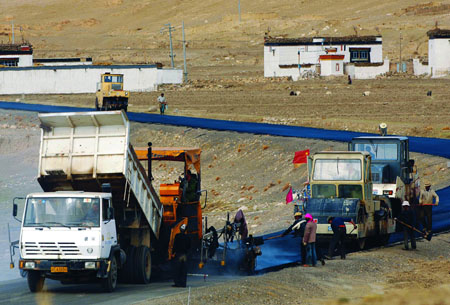| In 2006, Tibet used 4.058 billion Yuan for construction of highways. Construction began successively on nine projects, such as renovation of the Shiquanhe-Ritog, Gunsa-Bumin and Gogyi-Sangsang sections of Xinjiang-Tibet Highway, reconstruction of the Mangkam-Gejie River section of the Yunnan-Tibet Highway and Nylam-Zham section of the China-Nepal Highway, renovation of the Kangmar-Yadong and Nanggarze-Gyangze sections of the asphalt road in Tungxian County and the Mainling-Nang Highway, and the reconstruction of Yadong-Nathula Highway. Six projects were completed for the renovation of key highways such as the Guxiang-Tongmei section of Sichuan-Tibet Highway, Xigaze-Lhaze section of China-Nepal Highway, the geological renovation of the Togba-Qamdo section of No.317 National Highway, Dopoma-Rewoqe section of the Yunnan-Tibet Highway, as well as the reconstruction of the Shaquka-Biru and Sangri-Qusum sections of the asphalt road in Tungxian County.
Tibet attaches great importance to the road construction in rural areas. In 2006, it invested 1.032 billion Yuan to carry out 43 projects for rural road construction, providing vehicular access to 12 towns and 123 administrative villages. At the same time, active efforts were also made to bring farmers and herders into road construction, renting their tools as well as purchasing the sandstone they had dug out. In the process, local people gained additional income of 563 million Yuan.
Tibet has also worked actively to adjust the road transportation structure, adding regular buses and tourist buses on popular routes and opening seven new routes for passenger traffic in rural areas. Lhasa Newu Passenger Transportation Station and nine county-level passenger transportation stations met the demands of economic and social development in this regard, which promoted the development of the transportation industry in Tibet in an all-round way. At the end of 2006, highways open to traffic in Tibet extended 44,813 km, increasing 1,334 km from 2005, of which, the paved roads extended 1,984 km, a rise of 481 km. By the end of 2006, the total number of motor vehicles for civilian use reached 143,900, up 35.2 percent over 2005.

More than 4.058 billion Yuan was invested in construction of highways in Tibet in 2006. The figure was a historical high.
|





